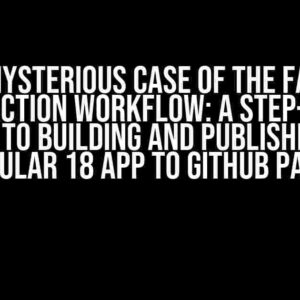As a developer, you understand the importance of testing and reporting in ensuring the quality and reliability of your native iOS app project. Azure DevOps provides an excellent pipeline system to automate these processes, but getting reports from these tests can be a daunting task. Fear not, dear reader, for today we’ll demystify the YAML file required to get a report from the tests on the Azure DevOps pipeline for a native iOS app project.
Prerequisites
Before we dive into the YAML file, make sure you have the following setup:
- An Azure DevOps project with a pipeline created for your native iOS app.
- The
xcodetask installed and configured in your pipeline. - Familiarity with YAML files and Azure DevOps pipeline configuration.
Understanding the YAML File Structure
Azure DevOps pipeline YAML files follow a specific structure, which includes:
trigger:
- main
pool:
vmImage: 'ubuntu-latest'
steps:
- task: xcode@5
displayName: 'Xcode build and test'
inputs:
...
In the above example, we have a basic YAML file with a trigger, pool, and a single step using the xcode task. We’ll build upon this structure to include the necessary configurations for testing and reporting.
Configuring the Xcode Task for Testing
To run tests and generate reports, we need to configure the xcode task with the following inputs:
steps:
- task: xcode@5
displayName: 'Xcode build and test'
inputs:
Actions: 'build test'
Configuration: 'Debug'
Sdk: '$(SDK)'
Scheme: '$(SCHEME)'
XcodeWorkspacePath: '**/untitled.xcworkspace'
XcodeProjectPath: '**/untitled.xcodeproj'
XcodeTarget: '$(TARGET)'
XCTestRun: true
XcTestReportPath: '$(System.ArtifactsDirectory)/test_results.xcresult'
In this configuration, we’ve added the following key inputs:
XCTestRun: Set totrueto enable test running.XcTestReportPath: Specifies the path where the test results will be saved.
Generating the Test Report
Now that we have our tests running, let’s configure the YAML file to generate a report:
steps:
- task: xcode@5
displayName: 'Xcode build and test'
inputs:
...
- task: PublishTestResults@2
displayName: 'Publish test results'
inputs:
testResultsFiles: '**/test_results.xcresult'
testResultsFormat: 'JUnit'
mergeTestResults: true
We’ve added a new step using the PublishTestResults task, which:
- Publishes the test results to Azure DevOps.
- Specifies the format as JUnit, which is compatible with Azure DevOps.
- Merges the test results, ensuring a single report is generated.
Visualizing the Test Report in Azure DevOps
After configuring the YAML file, your pipeline will generate a test report in Azure DevOps. To visualize this report, follow these steps:
- Navigate to your Azure DevOps pipeline and select the latest run.
- Click on the “Tests” tab.
- Select the “Tests” tab within the “Tests” tab (yes, it’s a bit confusing).
- You should now see a summary of your test results, including pass/fail counts and individual test results.
Tada! You now have a comprehensive test report for your native iOS app project in Azure DevOps.
Full YAML File Example
Here’s the complete YAML file example:
trigger:
- main
pool:
vmImage: 'ubuntu-latest'
steps:
- task: xcode@5
displayName: 'Xcode build and test'
inputs:
Actions: 'build test'
Configuration: 'Debug'
Sdk: '$(SDK)'
Scheme: '$(SCHEME)'
XcodeWorkspacePath: '**/untitled.xcworkspace'
XcodeProjectPath: '**/untitled.xcodeproj'
XcodeTarget: '$(TARGET)'
XCTestRun: true
XcTestReportPath: '$(System.ArtifactsDirectory)/test_results.xcresult'
- task: PublishTestResults@2
displayName: 'Publish test results'
inputs:
testResultsFiles: '**/test_results.xcresult'
testResultsFormat: 'JUnit'
mergeTestResults: true
Copy and customize this YAML file to fit your project’s needs, and you’ll be well on your way to generating comprehensive test reports for your native iOS app project in Azure DevOps.
Conclusion
In this article, we’ve demystified the YAML file required to get a report from the tests on the Azure DevOps pipeline for a native iOS app project. By following these step-by-step instructions, you’ll be able to generate a comprehensive test report, providing valuable insights into your project’s testing and quality.
Remember to customize the YAML file according to your project’s specific needs, and don’t hesitate to reach out if you encounter any issues or have further questions.
| Keyword | Answer |
|---|---|
| What’s the YAML file to get a report from the tests on the Azure DevOps pipeline for a native iOS app project? | The YAML file structure, xcode task configuration, and publish test results task configuration explained in this article. |
Happy testing and reporting!
Frequently Asked Question
Get the scoop on generating a report from tests on Azure DevOps pipeline for native iOS app projects!
What is the purpose of the yaml file in Azure DevOps pipeline for generating a report from tests for native iOS app projects?
The yaml file in Azure DevOps pipeline serves as a configuration file that defines the pipeline’s workflow, including the testing process, and enables the generation of a report from the test results for native iOS app projects.
What is the minimum required configuration in the yaml file to get a report from tests on Azure DevOps pipeline for native iOS app projects?
The minimum required configuration includes the `script` section to run the tests, the `publish` section to publish the test results, and the `report` section to generate the report from the test results.
Can I customize the report generated from the yaml file in Azure DevOps pipeline for native iOS app projects?
Yes, you can customize the report by configuring the `report` section in the yaml file to include or exclude specific test results, and even add custom sections or metrics to the report.
What is the typical structure of a yaml file for generating a report from tests on Azure DevOps pipeline for native iOS app projects?
The typical structure includes a `trigger` section to define the trigger for the pipeline, a `pool` section to define the agent pool, a `steps` section to define the testing and reporting tasks, and a `report` section to generate the report from the test results.
Are there any specific yaml file configurations required for native iOS app projects compared to other project types?
Yes, native iOS app projects require additional configurations, such as specifying the Xcode version, setting the target architecture, and configuring the signing and provisioning profiles, which are specific to iOS development.



